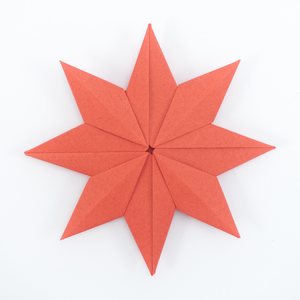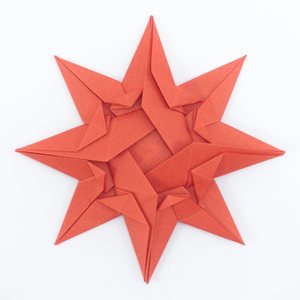Maple Leaf (CFW 149)


This star, designed by Shuzo Fujimoto, is based on a square twist and has eight rays. Its hexagonal twist counterpart (with twelve rays) is Chrysanthemum (CFW 142) and version made from other polygons are also possible (pentagon: CFW 156, heptagon: CFW 164).
In Twist Origami I, this model appears two times, on pages 19 and 27. These two appearances differ by having lines drawn on either only four or on all eight rays of the star. However, in my opinion, it is the same model and the difference comes only from either drawing creases on flat parts of the model in the same way as places with additional layers. Folding according to instructions on page 27 results in exactly the same final look as the picture on page 19 if we differentiate between places with multiple layers and flat creases. This difference would be marked on a diagram following the Yoshizawa-Ranbdlett system, but Fujimoto did not use it in his book.
This model also appears in Invitation to Creative Playing with Origami. On page 109 there is a drawing of the finished model and on page 114 a photograph of an actual folded model. There is a small discrepancy between the two: looking at the back side, one can notice that the negative space square in the center is much larger in the folded model than in the drawing. My fold, following the step-by-step instructions from Twist Origami 1, resulted in the smaller square, consistent with the drawing. Perhaps this is just an optical illusion (photos show the model at an angle rather than straight down), or a minor variation in how the layers of paper are tucked underneath. Fujimoto seems to not have paid much attention to such small details (indeed, you can consider them an issue simialr to shaping) and has for example freely mixed instructions for the handle variant with a hexagonal backdrop in the center (CFW 133) with pictures of a finished model without it (CFW 174) which I have classified as two separate variants.
Comments